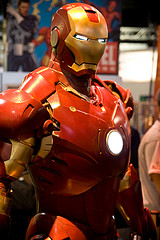 Io9 has tallied how close we are to the capabilities of the battle suit in “Iron Man,” and how much it would cost to replicate (sort of) such a suit. Their breakdown:
Io9 has tallied how close we are to the capabilities of the battle suit in “Iron Man,” and how much it would cost to replicate (sort of) such a suit. Their breakdown:
- Exoskeleton — $10 million
- Head-up display — $54 million
- Portable power source — $36 million
- Jet packs — $400,000
- Wearable computers — $20,000
- TOTAL: $100 million
They correctly note that this is roughly the cost of an F35 fighter plane. Given that such a suit has capabilities much greater than such a fighter plane, why aren’t we making them? Because we can’t.
- Power: We don’t have anything that can generate anything like the output of Iron Man’s power pack, so the suit would be far weaker than the movie version.
- Flight: Because of the power problem, a flying suit could not fly long or far.
- Armor: Today’s exoskeletons are not armored. Even if we could build a powerful suit, it could not stand up against even small-arms fire, much less cannons and missiles. And the more we armor present-day exoskeletons, the slower and clumsier they’d be.
On the positive side, we could build a highly capable head-up display for a fraction of $54 million, so the wearer would be able to see which insurgent with a $200 AK-47 knockoff was going to take him down.
The power and armor problems are not insurmountable, but a battle suit that is fast, agile, powerful, and armored still seems to be decades away.
(Image courtesy BobbyProm, Flickr)
